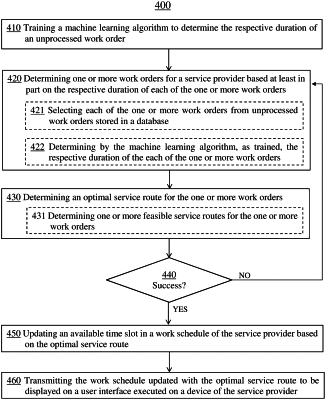| CPC G06Q 10/063112 (2013.01) [G06Q 10/063116 (2013.01); G06Q 10/0633 (2013.01)] | 20 Claims |

|
1. A system comprising:
one or more processors; and
one or more non-transitory computer-readable media storing computing instructions that, when executed on the one or more processors, perform:
training a machine learning algorithm to determine an estimated duration of a new work order, based on (a) historical input data for the machine learning algorithm and (b) historical output data for the machine learning algorithm, wherein:
the historical input data comprise a respective trade or a respective problem code of each of one or more fulfilled work orders;
determining, in real-time, one or more work orders for a service provider based at least in part on a respective duration of each of the one or more work orders, comprising:
selecting, in real-time, each of the one or more work orders from unprocessed work orders stored in a database; and
determining, in real-time by the machine learning algorithm, as trained, the respective duration of the each of the one or more work orders;
determining, in real-time, an optimal service route for the one or more work orders by calculating a score for the optimal service route by a mathematical formula associated with the one or more work orders, wherein:
the mathematical formula is Σi=0nΣj=1, i≠jn+1(eij*wij), wherein:
n comprises a count of the one or more work orders in the optimal service route;
bij comprises an indication of whether a jth work order (WOj) of the one or more work orders is scheduled immediately after and adjacent to an ith WO (WOi) of the one or more work orders in the optimal service route, wherein:
when WOj is scheduled immediately after and adjacent to WOj, bij is equal to 1;
when WOj is not scheduled immediately after or adjacent to WOj, bij is equal to 0;
∀i∈{0, n};
∀j∈{1, n+1};
WO0 comprises a virtual work order for a starting location of the service provider; and
WOn+1 comprises a virtual work order for an ending location of the service provider; and
eij comprises a priority score for bij determined based on eij=Σk=1mwjk*fjk/sij+c, wherein:
m comprises a count of one or more weighted factors associated with WOj;
Wjk comprises a respective weight for a kth factor of the one or more weighted factors associated with WOj and determined by a second machine learning model;
fjk comprises a respective value for the kth factor of the one or more weighted factors associated with WOj;
sij comprises a respective normalized drive time value between a respective service location of WOi and the respective service location of WOj, and
C comprises a constant number;
updating, in real-time, an available time slot in a work schedule of the service provider based on the optimal service route; and
transmitting, in real-time through a computer network, the work schedule updated with the optimal service route to be displayed on a user interface executed on a device of the service provider.
|